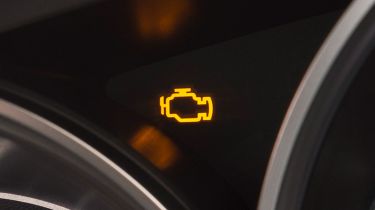Engine management light: what to do if it comes on
We cover what to do if your engine warning light comes on and the most likely causes

Among all of the dashboard warning lights in your car, an engine management light (EML) is one of the most important. It’s used to signify an issue with your car’s engine, so if it comes on unexpectedly, it’s important to know what to do.
The engine management light – also referred to as an ‘engine warning light’ or ‘check engine light’ – is universal across practically every car model. It looks like the outline of a typical engine and will illuminate if there’s an issue.
 My car won’t start: why, what you can do and troubleshooting
My car won’t start: why, what you can do and troubleshooting
Depending on the severity of the issue, the engine management light will illuminate either orange or red. While it’s sometimes possible to drive with an orange engine management light turned on (this may be yellow in some cars), a red engine management light signifies a serious issue and you should pull over in a safe location immediately – read our top tips for staying safe if your car breaks down.
If your engine management light illuminates, your car may also enter ‘limp mode’, too. The car’s computer will restrict engine power to reduce the risk of further damage, but you should still be able to drive and pull over to a safe location where you can turn it off.
Either way, an engine management light will usually require immediate attention from a professional to diagnose and fix the issue. Keep reading to find out what to do if your engine management light comes on, how to reset it and the top five most common causes.
What should I do if my engine management light comes on?
So your engine management light has come on – what now? If you’ve just turned your car on and aren’t already on the move, it’s best not to drive your car. You don’t know how serious the issue is, so it’s best to stay put for now until you figure out the cause of the light.
If you’re already driving and your engine management light has suddenly illuminated, you’ll want to make note of the colour of the light. Most cars use a colour-coded system for the EML, with an orange, amber or yellow light used for non-critical issues, and red for more serious problems. Follow the steps below for each scenario.
What to do if the engine management light is orange
An orange, amber or yellow engine management light signifies a non-critical engine issue. If everything seems normal from behind the wheel, you should be fine to continue driving to your destination where the issue should be investigated.
If something feels or sounds unusual about the way the car drives, don’t risk driving any further – stop in a safe place immediately. Driving for prolonged periods of time with an amber engine warning light increases the chance of serious engine damage, so it’s best to have a professional look into it as soon as possible.
If you suspect that the orange engine management light has come on in error, or that the issue has fixed itself, you can try resetting the light. Stop somewhere safe, turn off the ignition and wait 20 to 30 seconds before restarting the car. If the light has turned off, you will be safe to continue driving. If the light remains illuminated, you can continue driving to your destination with caution, or call for a recovery service.
What to do if the engine management light is red
A red engine warning light indicates that there is a serious issue with the engine. You should pull over to the side of the road and turn off the engine as soon as it's safe to do so. Do not try to restart the engine as this could cause further damage. You will need to call for a recovery service.
What does an engine management light mean?
If you’ve spotted an orange or red engine symbol appear on your dashboard, this is an engine warning light and it means something’s gone wrong with your car.
The thing is, an engine warning light doesn’t have just one meaning. Instead, it’s a general warning that something is wrong with the engine – it could be something to do with the emissions system, the fuel supply, the ignition system, or something else. That can make it a bit harder to figure out exactly what has gone wrong.
This is unlike other warning lights, such as the coolant temperature warning or low oil level warning lights, which signify one specific issue with the car. However, there are some common causes for an engine warning light that we’ve covered further down in this guide.
In some cases, the engine light can even signify an issue with the brains of the car, known as the ECU or ‘Engine Control Unit'. It’s best to investigate the engine and mechanical parts first, but if there’s still no clear cause, get an expert to check if your ECU is working properly and that it’s not damp, especially in an older car.
While the majority of cars use the traditional engine symbol for their engine warning light, some older cars might display a ‘check engine’ message instead. Some older cars might also flash this ‘check engine’ warning a specific number of times, with the number of flashes referring to an error code which can be found in the car’s manual to tell you what’s wrong.
In most cases, the car will need to be connected to diagnostic equipment to determine the fault – most service centres and breakdown service providers can do this.
Can I drive with an engine management light on?
As a general rule, we don’t recommend driving with an engine management light on, as it’s tricky to know just how serious the problem is and driving may make things worse. That said, there are some scenarios where you should be ok to do so for short periods of time.
Whether you can drive with an engine management light on depends on the colour of the light and if anything feels unusual from behind the wheel. That second point is very important – if the engine warning light comes on and you notice an unusual feeling or sound, such as more vibration or an abnormal sound coming from the engine, you should stop driving the car immediately, regardless of the colour of the light.
If the engine warning light is amber and you don’t notice any unusual feelings or sounds, there is still something wrong with the engine, but it doesn’t pose an immediate risk of breaking. You should be able to continue driving to your destination where you should seek advice. If you’ve just turned on your car and are yet to set off, we’d recommend staying put or taking the car to a garage to let a professional investigate.
If the engine warning light is red, you should not drive any further. Stop where it is safe and arrange for your car to be recovered to a garage. Driving further with a red light could potentially cause expensive damage to the engine.
Will my car pass its MOT with an engine management light?
No, an illuminated engine management light is an automatic MOT test fail. In 2018, stricter MOT rules were introduced meaning that any car undergoing an MOT test with an illuminated engine management light (whether it’s a red or amber warning) would fail.
Prior to taking your car for an MOT test, it’s worth checking that all warning lights go out when you start the engine; it’s normal for the engine management light to illuminate with the ignition prior to starting, but it should always go out once the car is running.
How do I reset the engine management light?
Resetting the engine management light varies from model to model. Some older cars will include instructions in the handbook, but many modern cars are too sophisticated and require a service centre to diagnose the issue and reset the warning light.
You can purchase your own vehicle diagnostic readers, with prices varying depending on brand and capability. All modern cars use the same style socket for diagnostic readers, known as OBD-2, usually located under the dashboard. Once plugged in, the reader will provide a code relating to the specific cause of your engine warning light and will allow you to reset it.
Whilst they’re a handy and affordable tool, we recommend taking your car to a specialist to investigate. Resetting the light yourself may make the engine warning light disappear, but it won’t solve the issue that caused it to trigger in the first place.
In rare cases, an engine management light may be triggered by mistake, through a software bug or a faulty sensor. If everything feels and sounds normal, you can try resetting the light by turning off the ignition, waiting for 20 to 30 seconds, and turning the car on. If the light has gone out, the problem will most likely have rectified itself, but be warned that it could reappear with further driving.
Top 5 causes of an engine management light
The list of possible triggers for an EML is a long one, but here are five of the most frequent causes:
1. Emissions system fault
One of the most common causes of an EML is an issue with the car’s emissions system. This uses a series of sensors to ensure the system is operating correctly.
One key component is the oxygen sensor, with many cars having more than one. This measures the amount of unburnt oxygen passing through the exhaust of the car, which can indicate whether the engine is burning too much or too little fuel, known as running ‘rich’ or ‘lean’, respectively.
An EML triggered by the oxygen sensor can mean the car is running too rich or too lean, or can be caused by a fault with the sensor itself. If your car is running too rich or too lean for an extended period of time, it can lead to further issues, making a repair more complicated – and expensive.
Putting this fault right may involve the reprogramming or recalibration of the engine control unit (ECU) or, sometimes, the replacement of the oxygen sensor.
2. Blocked diesel particulate filter or differential pressure sensor fault
These issues are exclusive to diesel cars and will trigger an EML or, in some cases, a dedicated diesel particulate filter (DPF) warning light. The latter can also trigger if the car detects a fault with the differential pressure sensor (DPS), which determines how effectively the DPF is performing.
The DPF is designed to remove carcinogenic particles from the exhaust fumes. These particles take the form of a sooty deposit, and over time the filter can become clogged, making it difficult for the exhaust gases to pass through. When the DPS determines this point has almost been reached, the engine begins a process called DPF regeneration.
This involves extra fuel being burnt by the car in order to increase the temperature of the DPF. When it gets hot enough, the particulates are burned and pass harmlessly through the exhaust as fine ash, unclogging the DPF.
If you only use your diesel car for short journeys, it’s likely that your DPF will never reach a high enough temperature for the regeneration process to occur. The DPF will remain clogged and can trigger the EML. If you own a diesel car that you typically only use for short trips, we recommend taking your car out for longer drives as and when possible to avoid this type of issue developing – or swapping to a car that runs on petrol or electricity.
However, a faulty differential pressure sensor can also create the same symptoms. If it’s producing an incorrect reading – or none at all – the car doesn’t accurately know how full the car’s DPF is. It can then sometimes trigger ‘limp mode’ mode to avoid the risk of damage until the fault can be investigated.
If you suspect your diesel car has a blocked DPF filter or a faulty DPS, take it to a service centre where the issue can be investigated and resolved.
3. Mass airflow sensor
The mass airflow sensor (MAF) – sometimes referred to as the air mass sensor or mass flow sensor – is vital for the efficient running of an engine. It lets the car’s computer know how much oxygen is entering the engine, so it can calculate the correct amount of fuel to add.
If the MAF fails or provides inaccurate data, the car’s computer has to guess how much fuel to add, and an EML will illuminate. The car will continue to run, but it may enter limp mode, reducing engine power.
The mass airflow sensor is mounted towards the top of the engine, where it’s in the path of air that has just passed through the engine’s air filter. An incorrectly installed (or missing) air filter can damage the sensor by allowing harmful particles to make contact with it.
Alternatively, a clogged air filter not letting enough air through will trigger a warning that the engine is being forced to run ‘rich’. Whether the signal given by the mass airflow sensor is missing or outside normal parameters, the effect will be the same – an engine warning light.
4. Ignition system fault
Not to be confused with the ignition key or ignition switch, the ignition system is responsible for burning the fuel that makes an engine run. An EML will trigger if one of its components fails.
In a petrol car, a mixture of fuel and air is ignited by a spark plug. The spark plugs need a very high voltage to create a spark, provided by one or more ‘coils’ – usually one per cylinder. If a spark plug or coil develops a fault, the fuel in that cylinder won’t burn effectively, resulting in a rough or ‘misfiring’ engine.
This can also cause damage to your exhaust system’s catalytic converter. Your car’s computer can detect this and will trigger an EML. It’s usually a fairly simple fix, with either the faulty spark plug, coil or associated wiring needing to be replaced.

Diesel cars don’t need spark plugs to run, but instead use glow plugs to warm the combustion chambers before starting on a cold day. A dedicated glow plug warning light (usually a swirling line, resembling an insect with antennae) will illuminate if there is an issue with the ignition system in a diesel car.
5. Loose petrol or diesel filler cap
If your car’s EML has illuminated, and there are no obvious signs that something is wrong with the engine, the fuel cap could be the culprit and it only takes a moment to check.
Your car’s fuel tank is a complex, pressurised system that allows metered amounts of air from outside to replace the fuel as it’s pumped out of the tank to the engine. Air is allowed into the tank based on readings from a fuel tank air-pressure sensor, which is able to account for things like temperature that can also have an effect on the air pressure in the tank. If the fuel tank pressure sensor is unable to provide an accurate reading, it’ll usually trigger an EML.
However, the readings from the sensor can only be reliable if the fuel tank system is 100% pressure tight, with air only permitted to enter and leave the tank through the controlled vents. One common cause of an air leak into – or out of – the petrol tank, is through a fuel filler cap that hasn’t properly sealed. Check to make sure it’s seated correctly, or whether the cap itself is broken.
This is one of the cheapest-to-fix faults that can possibly trigger an EML, with a replacement fuel filler cap often typically costing around £10.
Frequently Asked Questions
If the engine warning light is amber, then you should be fine to continue driving to your destination before contacting a garage to have the car inspected, as long as nothing feels or sounds unusual. If the engine warning light is red, then you should stop driving as soon as it’s safe to do so.
Car technology made simple
- Car lights and headlights: complete guide
- Car cameras: how cameras are making cars safer
- Dash cams: what are they and how do they work?
- What is cruise control and adaptive cruise control?
- Electronic handbrakes and Auto-hold: a complete guide
- What is a car immobiliser and does my car have one?
- What is Alcantara?
- What is kerbweight?
- What is a space saver wheel?
- What is regenerative braking?
- What is gross vehicle weight?
- What is bluetooth?
- What is a head gasket?
- What are spark plugs and glow plugs?
- What are brake pads and discs?
- What is a supercharger?
- What is lumbar support?
- What is a car’s exhaust system and what can go wrong?
- What is air suspension, and how does it work?
- What are adaptive dampers, and how do they work?
- What is keyless entry and keyless start?
- eCall explained
- What is a head-up display?
- What is Waze?
- What is Mirrorlink?
- What is what3words?
Recommended

Classic car tax exemption: which historic vehicles qualify?
Most Popular
Tips & advice

Car dashboard warning lights: what does each symbol mean?

Electric car charging stations: public networks, charger types, apps and maps









